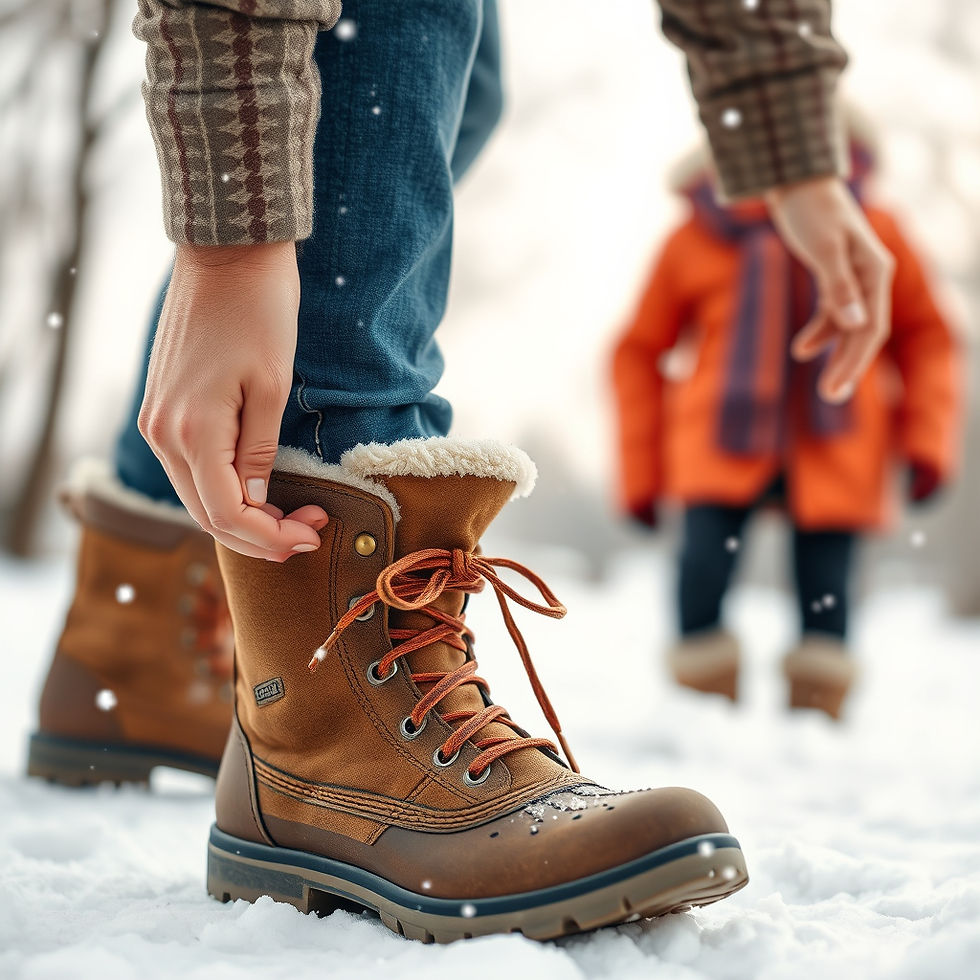Why Cold Weather Can Trigger Foot Pain and How to Find Relief
- Dr. Chandana Halaharvi

- Aug 19
- 3 min read
When the air turns crisp and temperatures drop, many people notice an unexpected side effect: their feet start to ache. For some, it’s a dull soreness that shows up after a walk in the cold. For others, it’s sharper pain that lingers long after they’ve warmed up inside.
Foot pain in the winter isn’t just in your head. Cold weather really can trigger discomfort in the feet, especially if you already have underlying conditions. The good news is there are practical steps you can take to keep moving comfortably through the season.
Why Cold Weather Affects the Feet
Feet are at the farthest point from the heart, which makes them especially sensitive to temperature changes. When the body gets cold, blood vessels in the hands and feet naturally constrict to preserve warmth for vital organs. That reduced circulation can leave your feet feeling stiff, sore, or even numb.
Winter pain can be especially noticeable for people with:
Arthritis: Cold temperatures may worsen joint stiffness and pain.
Poor circulation: Conditions like diabetes or peripheral arterial disease can limit blood flow, making feet more vulnerable to cold.
Nerve sensitivity: People with neuropathy may notice burning or tingling that gets worse in the winter.
Plantar fasciitis: Already inflamed tissues in the heel can feel tighter in the cold.
Understanding the connection between cold weather and foot health is the first step toward finding relief.

Common Types of Cold Weather Foot Pain
Not all foot pain feels the same, and the cold can bring out different problems depending on your health and activity level. Some of the most common include:
Stiff Joints and Aching Arches
For those with arthritis, cold weather often increases stiffness in the toes, midfoot, and ankles. Even simple movements like walking down stairs can feel harder when joints are less flexible.
Heel Pain from Plantar Fasciitis
Plantar fasciitis causes irritation of the band of tissue along the bottom of the foot. Winter often makes it worse because tight muscles and ligaments don’t stretch as easily in the cold.
Circulation-Related Pain
People with reduced blood flow may feel cramping, burning, or sharp pain after being outside for even short periods. Toes are especially sensitive to poor circulation in cold weather.
Nerve Discomfort
Neuropathy can cause tingling or burning sensations that intensify when feet get cold. Because nerve signals are disrupted, feet may also be more prone to injury without the person realizing it.
How to Protect Your Feet in Cold Weather
You can’t change the temperature outside, but you can control how you care for your feet. A few small adjustments go a long way toward reducing winter foot pain.
Choose the Right Footwear
Shoes are your first line of defense. Look for insulated shoes or boots that keep warmth in without feeling too tight. A roomy toe box helps maintain circulation. Avoid shoes that pinch or squeeze, as they can worsen cold-related pain.
Layer Smart with Socks
Wool or moisture-wicking socks provide both warmth and dryness. Cotton tends to hold moisture, which cools the feet. If your feet sweat, carry an extra pair of socks to change into during the day.
Keep Feet Moving
Movement improves circulation. Flex your toes, roll your ankles, or stand up and stretch if you’ve been sitting for a long time. Even a few minutes of movement helps blood reach your feet.
Stretch Before Activity
Cold muscles and ligaments are less flexible and more prone to injury. Simple calf stretches or rolling your foot on a tennis ball before a winter walk can help reduce strain.
Moisturize Daily
Dry, cracked heels are more common in the winter. A good moisturizer applied at night helps keep skin healthy and reduces the risk of painful fissures.
When It’s Time to See a Podiatrist
Occasional winter soreness is common, but persistent or severe pain is not something to ignore. You should consider seeing a podiatrist if:
Foot pain lasts more than a few days without improvement
Your toes or feet become discolored in the cold
You experience sudden swelling, redness, or sharp pain
Numbness or tingling interferes with daily activity
At Thrive Foot and Ankle, we see many patients who struggle with foot pain that worsens in cold weather. The right evaluation and treatment plan can make a big difference in how comfortably you move through the season.
Finding Relief This Winter
Cold weather doesn’t have to mean sore feet. With the right footwear, good circulation habits, and proactive care, most people can stay active and pain-free all season.
For expert care and personalized treatment plans, visit Thrive Foot and Ankle and book an appointment online to take the first step toward a more comfortable winter.




Comments